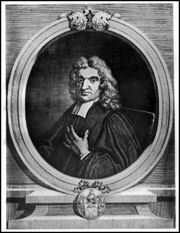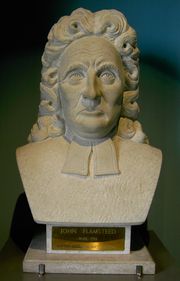John Flamsteed
2007 Schools Wikipedia Selection. Related subjects: Engineers and inventors
John Flamsteed, ( 19 August 1646 - 31 December 1719) was an English astronomer.
He was born in Denby, Derbyshire, England. He was ordained deacon and was preparing to take up a living in Derbyshire, when he was invited to London. On 4 March 1675 he was appointed by royal warrant "The King's Astronomical Observator" — the first British Astronomer Royal, with an allowance of £100 a year. In June 1675, another royal warrant provided for the founding of the Royal Greenwich Observatory, and Flamsteed laid the foundation stone in August. In February 1676, he was admitted a Fellow of the Royal Society, and in July, he moved into the Observatory where he lived until 1684, when he was finally appointed priest to the parish of Burstow, Surrey. He held that office, as well as that of Astronomer Royal, until his death. He is buried at Burstow.
Flamsteed accurately calculated the solar eclipses of 1666 and 1668. He was responsible for several of the earliest recorded sightings of the planet Uranus, which he mistook for a star and catalogued as 34 Tauri. The first of these was in December, 1690, which remains the earliest known sighting of Uranus by an astronomer.
On August 16, 1680 Flamsteed catalogued a star, 3 Cassiopeiae, that later astronomers were unable to corroborate. Three hundred years later, the American astronomical historian William Ashworth suggested that what Flamsteed may have seen was the most recent supernova in the galaxy's history, an event which would leave as its remnant the strongest radio source outside of the solar system, known in the third Cambridge (3C) catalogue as 3C 461 and commonly called Cassiopeia A by astronomers. Because the position of "3 Cassiopeiae" does not precisely match that of Cassiopeia A, and because the expansion wave associated with the explosion has been worked backward to the year 1667 and not 1680, some historians feel that all Flamsteed may have done was incorrectly note the position of a star already known.
Flamsteed is also remembered for his conflicts with another scientist, Isaac Newton, the President of the Royal Society at the time. The reason for this is that Flamsteed was refusing to publish work that had been commissioned by the king, and in 1712 Newton and Edmond Halley published a preliminary version of Flamsteed's Historia Coelestis Britannica without crediting the author. Some years later, Flamsteed managed to buy many copies of the book, and publicly burnt them in front of the Royal Observatory. However, the numerical star designations in this book are still used and are known as Flamsteed designations.
In 1725 Flamsteed's own version of Historia Coelestis Britannica was published. This contained Flamsteed's observations, and included a catalogue of almost 3,000 stars to much greater accuracy than any prior work. This was considered the first significant contribution of the Greenwich Observatory.
Honours
- Elected a Fellow of the Royal Society in 1676.
- Flamsteed crater on the Moon is named after him.
- John Flamsteed Community School in Denby, Derbyshire has been named after him.

